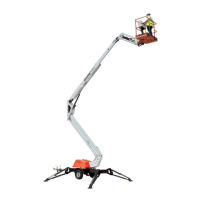Page 3 - 10 TL49J
PLATFORM CONTROLS
The platform controls is identical to the ground controls apart from the extra valve blank needed to
control the slewing platform ram. The orice in the platform slew tting is there to prevent the plat-
form from turning too quickly.
HAND PUMP
The hand pump enables lowering and operates the slew in case of an emergency. The pump is fed
from the general return line. It is theoretically possible to extend the cylinder with the hand pump but
the force required is excessive and the xing bracket for the hand pump is not designed to take such
a load. If no resistance is felt when operating the hand pump, try to operate the platform slew or the
drop nose to prime the pump.
PLATFORM SLEW
The cylinder has no lock valve. It relies on the closed centre of the spool to prevent it from moving.
ALL OTHER BOOM CYLINDERS
Lock valves are tted to prevent uncontrolled movement in case of hose failure.
STABILIZER CONTROL VALVE
In the centre position, this block has the B port connected to the tank. This is to ensure that the out-
rigger cylinder check valve closes quickly when setting up the machine. The 4 restrictors are there
to prevent cylinder juddering caused by the check valves tted to the outrigger cylinders.
The TL49J can be tted with a variety of power options. The battery powered machine has only
one solenoid valve tted (SOL 1). Both the engine and the mains powered version have a separate
dump valve tted (SOL 2). This is because oil is in circulation all the time and not just when a cylin-
der movement is required as on the battery version. Having oil circulating through the different valve
blocks may lead to uncontrolled movements should the controls be accidentally operated. By tting
the dump valve, the oil will always ow to tank unless the dump valve is activated.
Refer to the relevant circuit diagram under schematics or contact Snorkel or its local representative
for further information if required.
TOP & BOTTOM RAM
Each ram is tted with a manual release to enable lowering of the boom in case of an emergency.
Press down on the red button as shown in Figure 3-5 and hold. When released, the red button will
spring out and the movement should stop.
If the cylinder is operating erratically (jamming at odd intervals with the motor running), check that
the little restrictor disc tted at the nose of the car-
tridge is not loose. The disc is held in place with a
small circlip. Replace cartridge.
The O/C valve enables the oil to ow freely into the
cylinder but will not let any oil ow out until a pilot
signal is received when pumping oil into the annular
side of the ram. The O/C valve will then open up and
let oil ow out in a controlled manner.
The O/C valve is also tted with an adjustable
relief valve which must be set to 1.25 times the
maximum pressure inside the cylinder. If the
cartridge is marked with CBBA, the adjusting
screw is turned CCW to increase pressure.
If screwed fully CW, the cartridge is now fully
open and does not hold any load. The O/C valve
must be set correctly to ensure safe operation.
SERVICE AND REPAIR
Figure 3-5: A view of the manual release
valve and restrictor disc.
Restrictor Disc
Red Button
Courtesy of Crane.Market

